Best Metal Stamping Materials Selection
Welcome to the intricate world of metal stamping materials! My name is Sandra, and I am deeply entrenched in precision stamping parts and sheet metal fabrication. Through my business, Worthy Hardware, I’ve navigated the complexities of this industry, offering custom solutions to a diverse range of clients across sectors like electronics, military, aerospace, medical, automotive, and industrial machinery.
Selecting the ideal material for metal stamping is not just a task; it’s an art form. It requires a keen understanding of the material properties, the demands of the end application, and the nuances of the manufacturing process. In this guide, I’ll share my insights and experiences to help you navigate this critical decision-making process.
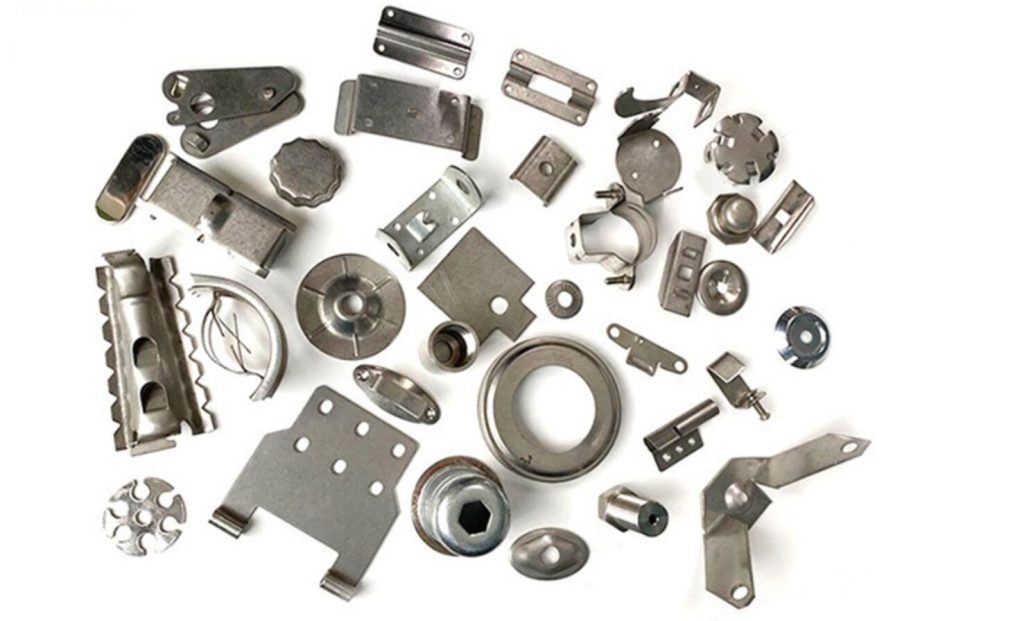
What Types of Material Could Be Used for Metal Stamping?
Metal stamping is a versatile process, compatible with a wide range of materials. Each material brings its unique properties and suitability for different applications. Here are some of the most commonly used materials in metal stamping:
Copper
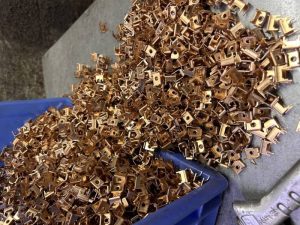
Copper stands out as a remarkable material in metal stamping, offering a unique blend of properties that make it an excellent choice for various applications.
Characteristics and Applications
- High Conductivity: Copper is renowned for its exceptional electrical and thermal conductivity. This quality makes it an indispensable material in the electrical and electronics industries, where efficient energy transfer is crucial. Components like electrical connectors, heat sinks, and battery contacts rely on copper’s conductive properties.
- Ductility and Malleability: Copper’s ductility and malleability allow for intricate and precise shaping, essential in creating detailed parts with minimal risk of cracking or breaking during stamping. This adaptability makes copper a favorite for decorative elements and functional parts in intricate assemblies.
- Corrosion Resistance: Its corrosion resistance ensures longevity and reliability in harsh conditions. This makes copper a go-to choice for plumbing, HVAC components, and outdoor applications, where exposure to elements is a given.
- Recyclability: An often-overlooked aspect of copper is its recyclability without losing properties. This aspect aligns with sustainable manufacturing practices, making copper an environmentally friendly option for eco-conscious industries.
Challenges and Considerations
While copper’s benefits are numerous, there are considerations to keep in mind:
- Cost: Copper is typically more expensive than common stamping materials like steel or aluminum. This cost factor should be weighed against the specific benefits copper provides for your application.
- Work Hardening: Copper can harden as it is worked, potentially affecting stamping. Proper annealing techniques are crucial to maintain the material’s workability.
- Surface Treatment: Depending on the application, copper parts may require surface
- treatments to enhance their appearance or resistance to tarnishing.
Steel
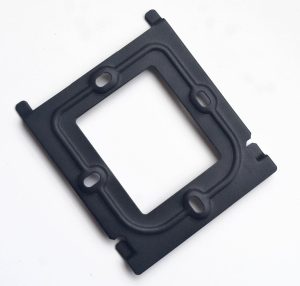
Steel is a cornerstone material in metal stamping, widely appreciated for its strength, versatility, and cost-effectiveness. As a fundamental component in countless projects, understanding steel’s properties and applications is crucial for optimal material selection.
Characteristics and Applications
- Strength and Durability: Steel’s high tensile strength makes it ideal for components that must withstand significant stress or weight, such as automotive parts, building structures, and industrial machinery.
- Versatility: Available in various grades, steel can be tailored to meet specific needs, whether higher strength, better weldability, or increased corrosion resistance.
- Cost-Effectiveness: Compared to other metals like copper or stainless steel, standard steel often comes at a more economical price point, making it a go-to choice for budget-conscious projects.
- Magnetic Properties: Certain steel grades possess magnetic properties, which are beneficial in applications like motors, generators, and transformers.
Challenges and Considerations
- Corrosion Susceptibility: Standard steel is prone to rust when exposed to moisture and oxygen. This limitation often necessitates additional protective coatings or treatments, particularly for outdoor or harsh environmental applications.
- Weight: Steel’s density can be a drawback in applications where weight is critical, such as in specific automotive or aerospace components.
Stainless Steel
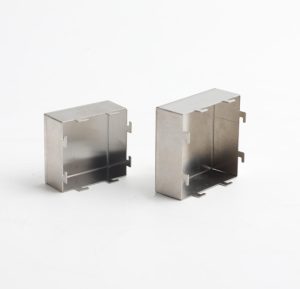
Stainless steel, an alloy of steel, is distinguished by its chromium content, which imparts significant corrosion resistance, elevating its utility in many applications.
Characteristics and Applications
- Corrosion Resistance: The defining characteristic of stainless steel is its resistance to rust and corrosion, making it ideal for use in environments exposed to moisture, chemicals, or saline.
- Aesthetic Appeal: Its sleek, modern appearance is favored in consumer products, architectural elements, and kitchen appliances.
- Hygienic Properties: Stainless steel’s non-porous surface makes it a preferred choice in medical equipment, food processing, and kitchenware, where sanitation is paramount.
- Heat Resistance: Certain grades of stainless steel can withstand high temperatures, making them suitable for applications like exhaust systems and heat exchangers.
Challenges and Considerations
- Cost: Stainless steel is generally more expensive than standard steel due to its enhanced properties.
- Work Hardening: It hardens quickly during machining and forming, requiring specialized tools and techniques.
- Variability in Grades: With over 150 grades available, selecting the appropriate grade of stainless steel is crucial and can be complex, depending on the application’s specific requirements.
Aluminum
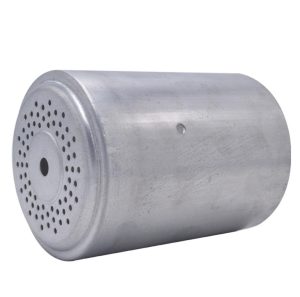
Aluminum is a highly sought-after material in the metal stamping industry, valued for its unique combination of properties that cater to a wide range of applications.
Characteristics and Applications
- Lightweight: Aluminum’s most notable feature is its low density, making it an ideal choice for applications where weight reduction is crucial, such as in aerospace, automotive, and consumer electronics.
- Corrosion Resistance: Naturally corrosion-resistant, aluminum is suitable for outdoor applications and products exposed to moisture, including marine equipment and architectural components.
- Conductivity: While not as conductive as copper, aluminum is still an excellent conductor of electricity and heat, making it a cost-effective alternative in electrical and thermal applications.
- Malleability and Ductility: Aluminum is easy to machine and form, allowing for the production of complex and intricate shapes, which is beneficial in modern design and manufacturing.
Challenges and Considerations
- Strength Limitations: While aluminum is vital for its weight, it is generally less strong than steel, which may limit its use in some high-strength applications.
- Surface Treatment: To enhance its appearance or further improve its corrosion resistance, aluminum often requires anodizing or painting.
Brass
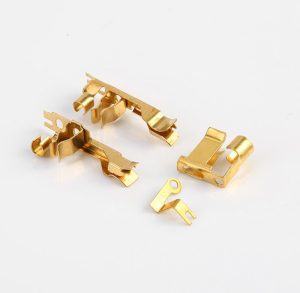
Brass, an alloy of copper and zinc, is another popular choice in metal stamping, offering a distinct set of properties.
Characteristics and Applications
- Acoustic Properties: Known for its excellent acoustic properties, brass is widely used in musical instruments, such as horns and bells.
- Machinability: Brass is highly machinable, making it a preferred material for precision components in industrial and consumer applications, including gears, valves, and fittings.
- Corrosion Resistance: Brass resists corrosion well, especially in water environments, making it suitable for plumbing, marine applications, and decorative items.
- Aesthetic Appeal: With its distinctive gold-like appearance, brass is often chosen for decorative purposes in architectural and interior design applications.
Challenges and Considerations
- Cost: Brass can be more expensive than other metals, like aluminum or steel, due to the cost of copper.
- Variable Properties: The properties of brass can vary significantly based on the ratio of copper to zinc, requiring careful selection to match the application’s specific needs.
- Lead Content: Some brass alloys contain lead to improve machinability. However, this can be a concern in applications where lead exposure is a risk, necessitating the use of lead-free brass in such cases.
Beryllium Copper
Beryllium copper, also known as beryllium bronze, is a remarkable material in the metal stamping industry, prized for its unique combination of strength, conductivity, and other beneficial properties.
Characteristics and Applications
- High Strength and Hardness: Beryllium copper is notable for its high strength and hardness, often comparable to steel’s, making it ideal for demanding applications such as aerospace components, precision instruments, and connectors.
- Excellent Electrical and Thermal Conductivity: It has superior electrical and thermal conductivity, making it a preferred material for electrical contacts, switches, and connectors in critical electronic applications.
- Non-Magnetic and Non-Sparking: This material is non-magnetic and non-sparking, which is crucial in applications where magnetic interference or spark hazards are a concern, like in oil and gas industries.
- Corrosion Resistance: Beryllium copper exhibits excellent corrosion resistance, especially in marine environments and against industrial gases, adding to its durability.
Challenges and Considerations
- Cost and Availability: Beryllium copper is generally more expensive than other copper alloys and can be more difficult to source due to the beryllium content.
- Health and Safety: Working with beryllium copper requires careful handling and specific safety measures, as beryllium dust and fumes can be hazardous if inhaled.
Phosphor Bronze
Phosphor bronze, an alloy of copper, tin, and phosphorus, is another widely used material in metal stamping known for its resilience and versatility.
Characteristics and Applications
- Excellent Fatigue Resistance: This alloy is particularly valued for its fatigue resistance, making it suitable for parts that undergo repeated stress, such as springs, bearings, and fasteners.
- Good Corrosion Resistance: Phosphor bronze is highly resistant to corrosion and wear, which is essential in marine applications and environments where chemical exposure is a concern.
- Low Coefficient of Friction: The low coefficient of friction makes it ideal for applications with moving parts, such as gears and bushings, where reducing wear and tear is essential.
- Sound Properties: Its unique acoustic properties make it a popular choice for musical instruments, particularly in manufacturing cymbals and strings.
Challenges and Considerations
- Cost: Phosphor bronze is generally more expensive than standard bronze or brass due to the addition of tin and phosphorus.
- Machinability: While machinable, phosphor bronze may require specialized machining techniques compared to more common copper alloys.
- Variable Properties: The properties of phosphor bronze can vary based on the alloy composition, necessitating careful selection for your specific application needs.
Titanium
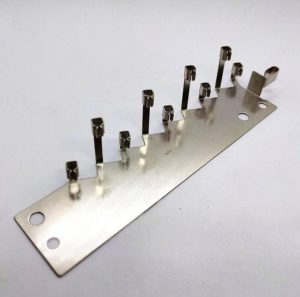
Titanium is a high-performance material in the metal stamping industry, renowned for its exceptional strength-to-weight ratio and other distinct properties.
Characteristics and Applications
- Exceptional Strength-to-Weight Ratio: Titanium’s most remarkable attribute is its strength-to-weight ratio, among the highest of any metal. This makes it an excellent choice for aerospace, military, and automotive applications where strength is crucial, but weight must be minimized.
- Corrosion Resistance: Titanium is exceptionally corrosion-resistant, even in harsh environments such as saltwater or exposure to corrosive chemicals. This quality makes it ideal for marine applications, chemical processing equipment, and medical implants.
- Biocompatibility: Titanium is uniquely biocompatible, meaning it is non-toxic and not rejected by the human body. This property is critical for medical applications, such as surgical instruments, orthopedic implants, and dental devices.
- High Melting Point: Its high melting point makes it suitable for high-temperature applications, such as jet engine components and high-performance exhaust systems.
Challenges and Considerations
- Cost: Titanium is more expensive than many other metals, reflecting its advanced properties and the complexity of its production and machining.
- Machinability: While titanium can be stamped and formed, it is more challenging to machine than many other metals. It requires specialized equipment and techniques, which can increase manufacturing costs.
- Limited Electrical Conductivity: Unlike metals like copper, titanium’s electrical conductivity is relatively low, which can limit its use in electrical applications.
What Factors Need to Be Considered When Choosing Materials for Metal Stamping?
Application Requirements
- Strength and Durability: Consider the mechanical stress the part will endure. Materials like steel and titanium are ideal for high-strength applications.
- Corrosion Resistance: Materials like stainless steel or aluminum offer superior resistance for parts exposed to harsh environments.
- Electrical and Thermal Conductivity: Materials like copper or aluminum are preferred in electrical and thermal applications.
Material Properties
- Ductility and Malleability: Essential for creating complex shapes without cracking. Copper and aluminum are excellent choices for intricate designs.
- Hardness: A crucial factor for wear resistance. Materials like hardened steel or beryllium copper might be necessary for high-wear applications.
- Weight: Lightweight materials like aluminum or titanium are critical for industries like aerospace or automotive.
Cost Considerations
- Material Cost: Balance the material’s benefits against its cost. While titanium offers exceptional properties, its cost might be prohibitive for specific projects.
- Production Costs: Some materials require specialized handling or processing, increasing overall production costs.
Manufacturing Process Compatibility
- Machinability: Materials like brass and phosphor bronze are known for their machinability, reducing tool wear and facilitating easier shaping.
- Formability: Materials should be compatible with stamping, considering factors like work hardening and springback.
Aesthetic and Finish Requirements
- Surface Finish: Consider the final appearance of the part. Materials like stainless steel or brass offer a visually appealing finish.
- Coating Compatibility: Some materials may require additional coatings or treatments for appearance or performance enhancements.
Availability and Supply Chain Considerations
- Material Availability: Consider the availability and lead times for sourcing materials.
- Supply Chain Reliability: Assess the stability and reliability of the supply chain for the chosen material.
What Problems Will Encounter With Improper Material Selection
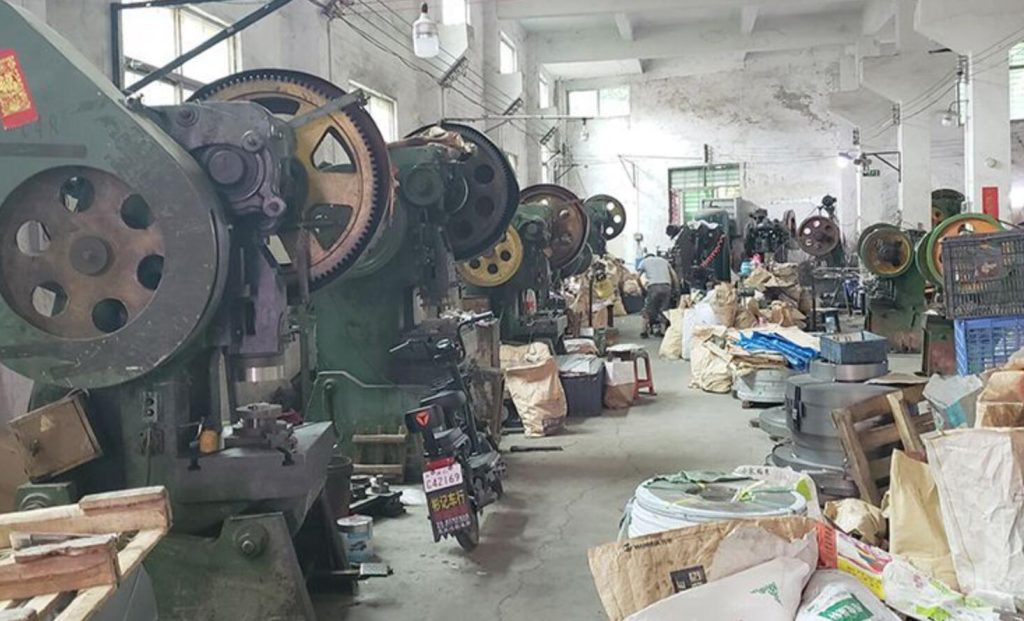
Reduced Product Life and Reliability
- Premature Wear and Tear: Incorrect material choice can result in parts that wear out quickly, especially in high-stress applications.
- Failure under Operating Conditions: Materials not suited to specific environmental conditions may fail prematurely, for example, rusting in a corrosive environment.
Safety and Compliance Issues
- Safety Risks: Using a material that isn’t strong enough for its intended use can lead to breakages, posing safety risks.
- Non-Compliance: Certain industries have strict material standards. Non-compliance can lead to legal and regulatory issues, especially in medical, aerospace, and automotive sectors.
Manufacturing and Assembly Challenges
- Difficulties in Machining or Stamping: Some materials are more challenging to process, increasing the risk of production delays or higher manufacturing costs.
- Incompatibility with Other Components: Materials with different thermal expansion rates or chemical properties can cause issues when combined with other components.
Aesthetic and Functional Shortcomings
- Poor Aesthetic Quality: The wrong material can affect the product’s look and feel, particularly important in consumer-facing applications.
- Inadequate Performance: For instance, choosing a material with insufficient electrical conductivity for electronic components can lead to performance issues.
Increased Costs
- Over-Spending on Over-Specified Materials: Using a more expensive material than necessary can inflate project costs without adding value.
- Additional Processing Costs: Some materials may require extra processing, such as coating or heat treating, to meet the project’s requirements.
How to Choose the Proper Materials for Metal Stamping
Define the Application Requirements
- Understand the End Use: Clearly define the purpose and environment in which the stamped part will be used. Consider factors like stress, exposure to elements, electrical or thermal needs, and aesthetic considerations.
Assess Material Properties
- Evaluate Key Properties: Match the requirements of your application with the properties of potential materials. This includes strength, flexibility, conductivity, corrosion resistance, and weight.
Consider Manufacturing Processes
- Machinability and Formability: Ensure the material is compatible with your stamping processes and tooling capabilities. Consider aspects like material hardness, thickness, and any special handling or processing it may require.
Analyze Cost Implications
- Material Cost: Compare the cost of various materials, considering the initial cost and the long-term value they provide.
- Manufacturing and Processing Costs: Factor in the cost of processing each material, including additional steps like heat treatment or finishing.
Check Compliance and Environmental Impact
- Regulatory Compliance: Verify that the material complies with industry-specific regulations and standards.
- Sustainability: Consider the environmental impact of the material, including its recyclability and the sustainability of its sourcing.
Consult with Experts
- Leverage Expertise: Engage with material suppliers, engineers, and industry experts to gain insights and advice on material selection.
- Prototype Testing: Create prototypes to test how the material performs in real-world conditions.
Conclusion
Worthy Hardware specializes in providing custom solutions for all your OEM precision stamping and sheet metal fabrication needs. Our expertise spans various materials and applications, ensuring you receive the best guidance and products tailored to your specific requirements.
Your success in metal stamping begins with the right material choice, and we are here to guide you every step of the way.

